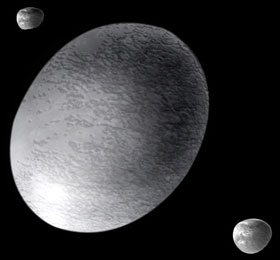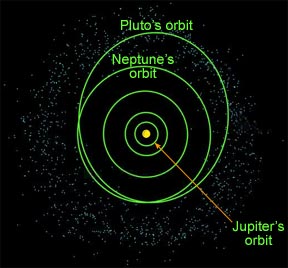Click on image for full size
Images courtesy of NASA, ESA, and A. Feild (STScI).
Moons of the Dwarf Planet Haumea
Haumea is a dwarf planet in our Solar System. Haumea has known moons, both discovered in 2005.
Hi'iaka is the larger moon. It has a diameter of about 310 km (193 miles). It orbits Haumea once every 49 days at a distance of 49,500 km (30,758 miles). Hi'iaka was discovered on January 26, 2005. It was discovered by a team of astronomers led by Mike Brown of the California Institute of Technology.
Namaka is the smaller moon. It is roughly 170 km (106 miles) across. Namaka orbits Haumea every 34.7 days at a distance of 39,300 km (24,420 miles). Namaka was discovered on June 30, 2005. It was also discovered by Mike Brown's group.
Astronomers think Haumea may have collided with another large object a long time ago. If true, that might explain the dwarf planet's odd shape and fast spin. The collision might have also created Haumea's moons. Pieces of debris left over from the collision may have come together to make the moons.
In Hawaiian mythology, Haumea is the goddess of fertility and childbirth. Hi'iaka and Namaka are two of her children. Namaka was a sea goddess or water spirit. Hi'iaka was the goddess of hula dancers. In some Hawaiian myths, Haumea's children were born by springing from various parts of the body of their mother. If Haumea's moons were created from pieces of the dwarf planet left over from a collision, then this may be the perfect myth. Maybe the two "children" (moons) really were "born" by "springing forth" from their "mother" (the dwarf planet)!
Mike Brown's team at Caltech first noticed Haumea right after Christmas in 2004. They used the nickname "Santa" for the new object until it was given an official name. When they found the moons, the Caltech team stuck with the Christmas theme. They nicknamed Hi'iaka "Rudolph" and Namaka "Blitzen"!









